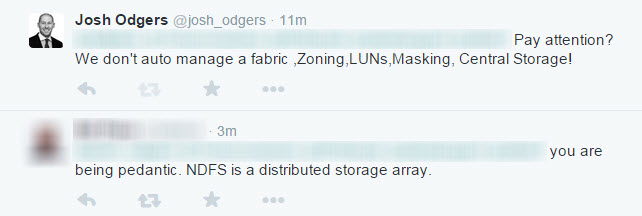Every now and again I see nonsense on twitter which I feel needs to be responded too. The reason I am responding today is to correct mis-information about what Nutanix NoSAN is.
Earlier today a competitor of Nutanix tweeted the following:
I responded to the above with the following tweet:
To which the person responded with this:
I responded with the below and the conversation ended with the following tweet:
So before I correct the mis-information, let me briefly explain what “SAN” is:
“SAN” or “Storage Area Network” describes the connectivity between a compute node and a storage device (such as a central storage array or disk system). You can for example buy SAN (or FC) Switch/es from companies like Brocade.
However the I.T industry has for whatever reason over the years has made “SAN” mean “Central Disk System / Storage array” so for the purpose of this post, “SAN” is a Traditional Centralized Storage array (SAN/NAS).
So let’s correct the mis-information:
Claim 1: With Nutanix there is a SAN that is auto managed.
Fact: There is no centralized storage with Nutanix
Nutanix software running NDFS (Nutanix Distributed File System) logically presents DAS storage as shared storage across 3 or more nodes via NFS or SMB 3.0 to ESXi, Hyper-V or KVM. Note: While Nutanix supports iSCSI, its not recommended as it creates unnecessary complexity and has no technical advantages.
All Nutanix nodes have local DAS storage which is presented logically as shared storage and there is no “central” Nutanix nodes.
Note: Nutanix nodes can connect to traditional central SAN/NAS storage (see : Can I use my existing SAN/NAS storage with Nutanix) but this is not Nutanix native architecture.
SAN’s also have key characteristics such as Zoning, Masking, LUNs, RAID, SANs also typically use Fibre Channel (FC) connectivity over dedicated fabrics although this is not always the case.
With Nutanix, There is no:
1. Central storage (SAN or NAS based)
2. LUNs
3. LUN masking
4. Zoning
5. Storage Controller “Pairs”
6. Dedicated Storage Fabric
7. Silos of storage capacity
8. RAID
Therefore the statement about Nutanix being a SAN that is “auto managed” is simply incorrect.
If a SAN “auto manages” LUNs, Zoning, Masking etc its just a smarter SAN, the problems with SAN (and NAS) cannot be solved by simply “masking” the complexity. (Pun intended)
Claim 2: NDFS is a distributed storage array.
Fact: NDFS is a file system, not a storage array.
Nutanix Distributed File System (NDFS) makes up part of the Nutanix solution, it is not a storage array and it is not centralised storage either.
Nutanix is a scale out shared nothing platform where data is written locally where the VM is running and in a distributed (not centralized) manner across nodes.
So what does NoSAN mean to me?
1. No centralized storage array
2. No LUNs, Zoning , Masking , RAID
3. No dedicated storage fabric (e.g.: Fibre Channel Switches)
4. Reduced complexity
5. No Silos of capacity
6. No Storage Controller “Pairs”
I could go on but I think you get the point.
In conclusion, don’t believe what you hear on social media (especially from competitors of a product) and do your own research and validate your findings from multiple sources.



Josh,
You are correct about SAN (especially the mistake that people make by using SAN as a term for the array, instead of the correct term regarding the network between the endpoints, and possibly the WHOLE of the endpoints as well).
It is my mistake for saying there’s a SAN inside. I should have said “there is an array inside”. I’ve gotten sucked into the mistaken use of that term myself.
That being said, the #NoSAN hashtag and marketing lingo implies that storage issues disappear. Yes, NDFS is a distributed storage file system. Since Nutanix “owns” all communication between nodes, and one cannot add a bare-metal non-Nutanix VMware node to the cluster, your NDFS distributed file system and any other managed HA capabilites are indistinguishable from a NAS array. It’s a closed system. And there’s nothing wrong with that.
I would prefer that we, on twitter, interact with a bit more, I don’t know, openness. Instead of taking your arguments to your website and blacking out my face, why not adjust my thinking online?
Sounds like your twitter buddy is a Nutanix competitor and is probably a little scared of them. Or they’re a product he/she is not allowed to sell for one reason or another.
Sorry, missed the first part where you say he’s a competitor. Isn’t that fun.
I wish our industry would stop talking about what things aren’t and concentrate on what they are. NoSQL, NoSAN, NoRAID the whole No thing doesn’t say anything positive or terribly helpful.
Interesting point Howard, I think it comes down to its easier to explain something when comparing it to something that is already well known. Agree its not always helpful in understanding what a product “is” though.
Aaron,
I am not scared of Nutanix. The whole reason this thread on Twitter opened up is that another Nutanix employee (not Josh) made some nearly unintelligible swipes at VMware and NetApp. I work for Pure, a competitor of NetApp, and Josh stepped in to correct my mistakes.
Nutanix isn’t taking money out of my kids college funds, believe me.
That’s Enough Bill, time to move on.
Pingback: Nutanix Platform Link-O-Rama | vcdx133.com